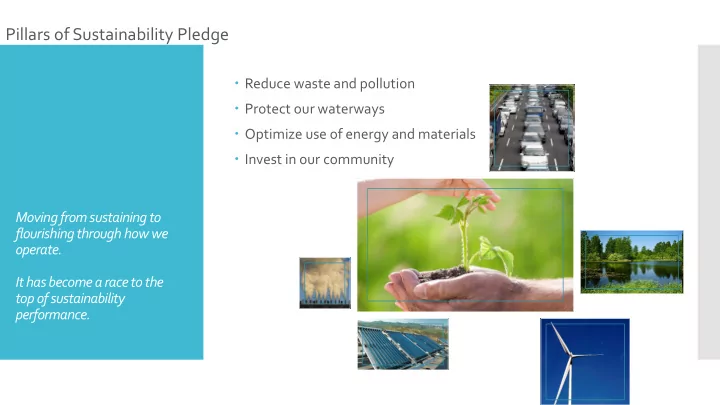

Pillars of Sustainability Pledge Reduce waste and pollution Protect our waterways Optimize use of energy and materials Invest in our community Moving from sustaining to flourishing through how we operate. It has become a race to the top of sustainability performance.
Why we measure Value Engagement Trust Competitive Advantage New generation employees . An active approach to corporate sustainability reaps value in the form of reputation building, cost savings, and growth opportunities.
Metrics that matter Accountability & transparency to stakeholders Improving public perception and brand image Improving processes, culture, and sustainability technology Competitive Advantage Staying current with best practices and benchmarking performance Corporate goals are being Plan aligned with environmental Value- Positive Thriving and social responsibility. based Impact, Metrics Business decision Competitive making advantage Consumers and investors are Education paying attention. Engagement Investment Resilience
Metrics that matter Defining metrics specific to organization The relationship between the types of metrics and thriving business Regulation can become part of solution Limitations, transparency, relevance Importance of tracking vs progress Internal corporate metrics are developed to meet specific business needs. Companies that communicate not only their successes, but challenges, Relevant Actionable Timely Measureable emerge as strong business leaders.
Industry Guidelines Guidelines Tools DOE FEMP As companies undergo the EPA evolution of sustainability WasteWise reporting standards and Portfolio Manager metrics, the presence of targets are less illuminating WaterSense than whether or not Regulatory companies are tracking Small business issues. EIA CBECS International Organization for Standardization (ISO)
Resources https://www.sce.com/wps/wcm/connect/a80ab052-b9a6-41d8- 895e-9544387725a6/BenchmarkingGuide.pdf?MOD=AJPERES http://www4.uwm.edu/shwec/recyclingtoolkit/PDF/EPATheMeasu reofSuccess_CalculatingWasteReduction.pdf http://carbonfund.org/how-we-calculate http://www3.epa.gov/watersense/commercial/index.html http://www.energy.gov/eere/femp/energy-and-cost-savings- calculators-energy-efficient-products http://www.epa.gov/cleanenergy/energy- resources/calculator.html https://www.globalreporting.org/resourcelibrary/English-Lets- Report-Template.pdf Metrics should be aligned http://www3.epa.gov/epawaste/conserve/tools/warm/Warm_For with goals. What are you m.html trying to achieve, and will https://www.energystar.gov/buildings/facility-owners-and- these metrics give you useful managers/existing-buildings/use-portfolio-manager information for that effort . https://www.eia.gov/ http://www.eia.gov/consumption/commercial/data/2003/#b1 http://www.nist.gov/
SBR Metrics Electricity Consumed (kWh/year) Alternative Energy Produced (kWh/year) Include Renewable Energy Certificate (REC)s Total Fleet Fuel Consumption (gals/year) Total GHG Emissions (OPTIONAL) Metrics are not just used for (metric tons CO 2 equiv./year) demonstrating progress or Water Consumed / Purchased (gals/year) telling a good story. Solid Waste Produced (lbs/year) Metrics are used to gather information for future Employee Volunteerism in Community (hours/year) decisions, understanding how programs are working, and for accountability
Example Electricity Blended Rate Customer Demand Energy Energy Intensity Leased Assets Ex. Tenant space 37,000 sqft, total building 100,000 sqft., 100% occupied = 37% total consumption Ex. Tenant space 37, 000 sqft, total building 100,000 sqf, Define, determine, engage. 50% unoccupied = 74% total consumption Using metrics to inspire new thinking, innovation, and Assumptions are critical action. Replicative Transparent Communication
Establishing Performance Metrics Plan performance metrics should answer the following questions: Are we executing our strategy? If we are not executing or do not know, what are the leading indicators that we will need to provide this information? Do we have the right strategy in place? Metrics must be visible and Source: Chris Davis, METIS Strategy (2013) “Managing Through well integrated with Metrics: The Other Sides of SMART.” business process
WNYSBR Metrics Reporting Form Creating a baseline allows for a better understanding of potential efficiencies.
WNYSBR Metrics Reporting Form Annual reporting serves as a mechanism to capture savings from both project specific initiatives and overall sustainability objectives.
Electric Utility Bill Example - kWh Understanding the resources readily available for reporting.
Water Utility Bill Example - Gallons
WNYSBR Metrics Reporting Form
WNYSBR Metrics Reporting Form
Next step: Taking Action A long term sustainability plan is ineffective without an action plan. Key next steps include: Identifying resources for taking action Establishing an ongoing communication plan Internal and external plans will likely differ Evaluating performance against plan targets Conducting management reviews Continuous improvement - Understanding of both current state and future trends is dynamic, so resulting plan should be viewed as a living document
WNY Sustainable Roundtable Reporting- Member commitment. On-going assistance to develop plans Metrics Template- SBR Website Templates due March 31, 2016 In a survey of 272 executives Questions? across 24 industries, 76% anticipate natural resource Break-out group discussions shortages will affect their core business objectives over the next 3-5 years.
Thank You! Aliesa Adelman, CSDP, LEED AP BD+C Sustainable Design Coordinator Wendel aadelman@wendelcompanies.com Trish Donohue, MS, QEP Senior Pollution Prevention Engineer Sustainable Supply Chain Program Manager New York State Pollution Prevention Institute, at Rochester Institute of Technology Patricia.Donohue@RIT.edu (585)425-4638 NYSP2I: http://www.rit.edu/affiliate/nysp2i/
Recommend
More recommend